Research Article
Role of Anti Diabetic Plants as Traditional Medicines
6273
Views & Citations5273
Likes & Shares
Diabetes is one of the serious metabolic disorders occurred due to the imbalance of glucose level because of damaged pancreatic β-cells and lower production of insulin in body. Type 1 diabetes mellitus (TD1) and Type 2 diabetes mellitus (TD2) are main types of diabetes. Major portion of the world is suffering from Type 2 diabetes mellitus. Drugs used for diabetes are insulin, biguanides, sulfonylurea and inhibitors for α-glucosidase. Traditional medicines are under trial to reduce diabetic complications with no/minimum side effects. Many antidiabetic plants are under potential research i.e., strawberry, jamun, mulberry, fenugreek, turmeric, black pepper, garlic, ginger, grapefruit, and cinnamon. All of these have antidiabetic potential. These plants have bioactive compounds present in minute amounts. These compounds act against inflammation, diabetes, bacteria, fungi, other microbial infections, and obesity. These plants have antioxidant potential as well. Through HPLC “High-performance liquid chromatography” screening, the compounds identified were caffeic acid, isoquercetin, kaempferol and other flavonoids. These compounds showed hypoglycemic activity. They are responsible for the increased uptake of glucose by the adipose and muscle tissues due to the activation of specific receptors i.e., PPARα “Peroxisome proliferator- activated receptors α” and PPARγ (Peroxisome proliferator-activated receptor γ). These activate the enzymes like glutathione, glutathione-S-transferase and catalase. Glutathione peroxidase inhibit the α-amylase then α-glucosidase lower glucose level. Effect of phytochemicals present in antidiabetic plants were studied in vitro and in vivo in animal models by inducing diabetes in them by streptozotocin, alloxan and diet on diabetic patients. Types of phytochemical compounds and their composition vary due to environmental factors, extraction and separation techniques which can have effect on clinical analysis. Bioavailability of oral drugs was also studied synergistically with these plants. Synthetic drugs, if are used with these natural compounds, they have no harmful effect but increase effectiveness. These herbal medications are more preferable, safe to use and cost effective due to which it is easily affordable by people. This review report covers the impact of these plants on diabetes mellitus reported so far.
Keywords: Diabetes, Damaged pancreatic β-cells, Type 1 diabetes mellitus (TD1), Type 2 diabetes mellitus (TD2)
INTRODUCTION
Diabetes mellitus is also defined as “hyperglycemia” a serious metabolic disorder in which glucose level is disturbed due to ineffectiveness in the production of insulin by the pancreas by damaging of β-cells or reduced production of insulin [1]. There are two types of diabetes i.e., Type 1 diabetes (TD1) and Type 2 diabetes (TD2). In TD1, immune system of the body destroys the beta cells of pancreas due to autoimmune diseases. It can be diagnosed in children and adults and it can be developed earlier than other diseases. It can be categorized as insulin dependent diabetes or juvenile diabetes because in this case patient has to take insulin regularly [2]. About 85% of diabetic patients are suffering from Type 2 diabetes mellitus. This increase in the ratio depends on lack of physical activity, presence of obesity, and way of lifestyle. Prevalence of diabetes was estimated nearly 171 million worldwide among adults with more chances of that the prevalence will be doubled to 366 million [3]. According to the WHO (World Health Organization) report of 2018, incidence of diabetes is increasing worldwide and causing a million death per year. Due to the imbalance in glucose level, there is an increased risk of glucose oxidation which results in forming free
radicals. This can cause the failure of several body organs [4]. Diabetes can also be progressed due to oxidative stress with other diseases [5]. β-cells (Beta cells) function can be disrupted by the various stressors which can lead to Type 2 Diabetes [6] (Figure 1).
Diabetes mellitus has a major impact on the economy. There are many complications regarding this disease and then its cost. This can reduce the quality and expectancy of life [7]. There is still no information regarding the mechanism of this disease i.e., progression and development. There might be some disturbance at the molecular level, signaling pathways which are involved in the regulation of glucose level [8].
In the case of insulin resistance, problems are caused during diabetes, many therapeutic approaches have been developed to overcome this problem. Many oral antidiabetic agents or drugs have been synthesized and some are under study. These can control the glucose level and other complications can also be lowered. During this approach, these drugs are the inhibitors that target the carbohydrate hydrolyzing enzymes and ultimately reducing the glucose absorption [9].
Therapeutic drugs have various targets. These targets include PTP1B (Tyrosine- protein phosphatase non-receptor type 1), PPARα (Peroxisome proliferator-activated receptors α), GLUT-4 (Glucose transporter type 4), PPARγ (Peroxisome proliferator- activated receptor γ), AMPK (5' Adenosine monophosphate-activated protein kinase), and DPP-4 (Dipeptidyl peptidase 4 [10].
Nowadays antidiabetic agents used are acarbose, sulfonylurea, thiazolidinedione, and biguanides. These drugs have different modes of action but all of these maintain the glucose level [8]. Drugs that are used to treat some diseases also have their side effects i.e., misbalancing the body functions or any kind of organ damage. Poor people can’t afford the drugs because they are expensive [9]. There are other risk factors that are involved in T2D i.e., obesity and family history. Decrease in insulin sensitivity and its response is the other major risk factor for youth. Youth gets prone to diabetes in two phases i.e., β-cell dysfunction in first phase, and secretion of insulin relative to sensitivity in the second phase responsible for impaired glucose tolerance [6]. Synthetic drugs that are available for diabetes treatment with their effects and mechanisms are explained in the Table 1.
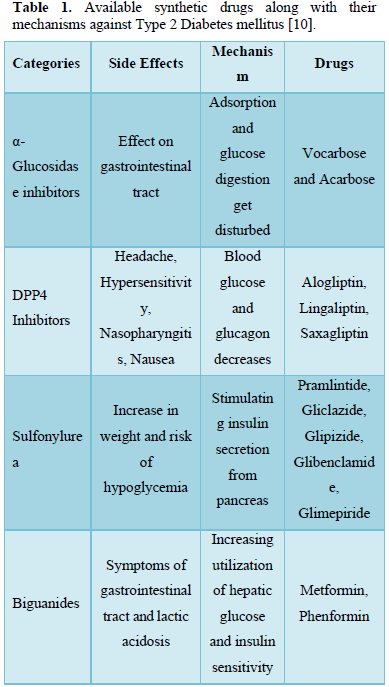

TRADITIONAL MEDICATIONS AGAINST DIABETES
Traditional medicine is an alternative to the conventional medicine and has been widely used all over the world from ancient times. Traditional medicine includes herbal medicine, also known by the names of botanical medicine or phytomedicine. Before the conventional medicine, herbal medicines were already in use. Herbal medicine has no harmful effects if it is used with conventional medicine [3]. Almost 1200 plants have been known to have antidiabetic properties [11]. Agents having antidiabetic potential, especially derived from plants or natural sources have fewer or no side effects. They have no toxicity, having an effective role in diabetes and they are less expensive. They can be affordable and easily available [1]. People from rural or far areas have more knowledge of traditional medicine with a great diversity of plants [12]. Different polyphenols derived from different plants have impact on metabolism of glucose in various ways which include stimulating the secretion of insulin from β-cells of pancreas, help to inhibit the carbohydrate breakdown, increase in the absorption of glucose in intestine, receptors activation of insulin. Thus, increasing uptake of glucose in insulin sensitive tissues. Figure 2 explains how phytochemicals manage glucose metabolism and oxidative stress [5].
Due to their use a wide range of complications associated with diabetes have been reduced [13], therefore traditional medicine cannot be neglected. It has many uses and it plays an important role in drug development and novel research. It is too valuable, and their safety has been proven by conducting various experiments [11]. Patients have a strong belief in herbal medicine and they always prefer them due to their affordability [3]. In most of the drugs that have been approved, almost 50% are derived from natural substances. About 80% of the world population prefer to use the medicines that are obtained from plants [14]. Experimentally, inhibitory activity is checked by α-glucosidase inhibition assay in which microplate, having 96 wells, is taken. Besides this, a positive control is used i.e., acarbose and this assay has to be performed three times and 50% of the enzymatic activity (IC50) should be inhibited by the sample [15]. Activation of specific receptors, PPARγ, that are the target for drugs or if we use the compounds with them then these receptors increase the uptake of glucose in adipose, liver or muscle cells by glucose transporters GLUT-1 and GLUT-4 this will balance the level of glucose in plasma [10].
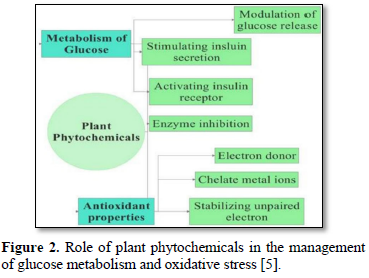

Herbal Treatments
After the struggles of many years, scientists have been able to synthesize new drugs from plants bark, stem, leaves, seeds, and plant fruit by knowledge of herbal medicine [16]. Plant parts or whole fruit is harvested and brought to the laboratory after which they are cleaned, frozen and ground till the fine powder form is obtained [17]. The plant parts are used for observations and identification of phytochemicals or clinical analysis by preparing their extracts. These extracts are prepared by mixing sample into methanol, ethanol or water. These extraction methods influence the chemical composition of compounds of plants as well as their activity for clinical purposes [12]. The phenolic compounds present in plants are also identified as hydroxylated aromatic rings and these combine together to form different compounds [18].
Based on observations many studies proved that higher fruit intake lowered the risk of diabetes [19]. Intake of food with enriched phytochemicals results in reducing the diseases and maintaining the oxidation reduction reactions in cells. Many researches and studies have been reported (in vitro and in vivo) which have shown that natural antioxidants either we take the as food, or in form of extract, they can manage the glucose level in body [5]. In the case of herbal medicine, they have many other benefits. Besides diabetes they can also regulate the body functions. These medicines have a different mode of actions due to the compounds present in plants, environmental factors (season, harvesting, preservation methods) and genetic variations of plants [20].
PLANTS AND THEIR USE IN TREATMENT AGAINST DISEASES
Dating back to erstwhile cultures, sickness typically believed to be due to deific punishment. For instance, some people (Aztecs Indian of South America), deemed that specific diseases were linked to specific deities; accordingly, a god of their called Tlaloc was related with illnesses instigated due to water, e.g., oedema [21]. In fact, those related diseases were unidentifiable (symptoms or causes), hence, were associated to God’s punishments. Nevertheless, eventually and gradually there had been traces of indication of the practice of plants for curative drives for sixty thousand years in eastern and western cultures as well as in both undeveloped & developed states. For illustration, the therapeutic use of plant’s extracts (Caster beans oil & poppy of opium) was written about 1500 BC in The Egyptian Pharmacopoeia of Ebers Papyrus [21].
Spices have been the oldest dietary supplement in which every spice have its own taste and flavor. These are mostly in dried form and obtained from plants seed, bark, roots, leaves, stem and fruit. They are full of polyphenolic compounds and have aromatic ring structure that give them specific taste and smell. These compounds have effective role in digestion and influence the metabolism. These spices have been tested experimentally on human and animal models such as diabetic rats in which they observed that these compounds have potential to activate the insulin production in normal as well as in experiment [22].
In this section, biological benefits of some common plants viz Cinnamon, Strawberry, Mulberry, Jamun, Neem, Black pepper, Fenugreek, Onion, Ginger, Grapefruit and Garlic will be discussed with respect to diabetes.
Cinnamon (Cinnamomum verum)
Cinnamon is widely used in food and has antidiabetic properties. This makes it valuable for human health. Research on cinnamon related to Type 2 diabetes has been in study for 20 years. In one of the reports, scientists found a factor and named it “Insulin potentiating factor (IPF)”, it is involved in mitigating the symptoms and risk associated with diabetes. Cinnamon improves the action of insulin which is due to the change in function of insulin receptor that activates the enzyme [22].
Cinnamon bark is one of the spices mostly used for flavoring. It has pharmacological, antiviral, antifungal, antibacterial, antioxidant properties which helps in digestion, lowering cholesterol and toothache. Activity of insulin can be checked by evaluating the effect of bovine serum album on cinnamon [23]. Oil extracted from cinnamon tend to have high antioxidant potential. A trial in which cinnamon with rice pudding was used on human and it showed that gastric emptying was delayed, and it caused the reduction in postprandial blood glucose. Cinnamon extract has also the property to inhibit the α-glucosidase activity of yeast. The effect of cinnamon extract was also observed on normal and rats induced diabetes by streptozotocin [24].
Effect of cinnamon was also studied on 60 patients. Patients were kept under observation in which 1, 3 and 6g of cinnamon dose for 40 days was given to them. The results showed that cinnamon can also lower glucose level and other diabetic complications. Inactive insulin receptors can be activated by polyphenols and chromium. These substances are present naturally in cinnamon. These substances improve insulin signaling pathway. Insulin receptors are phosphorylated and glucose level is regulated [23]. Some of the important compounds reported in cinnamon are caryophyllene oxide, L-bornyl acetate, α-cubebene, terpenoline, eugenol, α-terpineol, trans-cinnamaldehye and α-thugene. These phytochemicals from different parts of cinnamon with their compositions are mentioned in Table 2. The antidiabetic potential of cinnamon is shown in Figure 3.
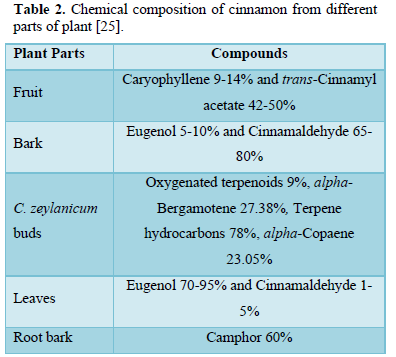

A flavonoid obtained from Ceylon cinnamon stem bark was named cinnamtannin B1. It is proanthocyanidin and helps to phosphorylate the β-subunit of insulin receptor on adipose cells and other receptors of insulin [26]. Cinnamon oil when combined with oregano, cumin, myrtle and fennel essential oils, increase the insulin sensitivity and reduction in level of glucose in diabetic rats with Type 2 diabetes, was observed. It also increases the synthesis of glycogen and activates the receptors. They can also improve the function of pancreatic beta cells by repairing them [27].
The antidiabetic effect was also studied from extract prepared from bark. Scientists administered various doses in Type 2 diabetic animal model (C57BIKsj db/db) in which highest dose was 200 mg/kg. The result showed reduction of glucose level significantly with the highest dose. They also noticed significant increase in high density lipoprotein cholesterol and insulin but there was also decreased amount of α-glucosidase activity and triglycerides when the duration of dose administration was 6 weeks. When 200 mg/kg of dose was given for 12 weeks reduced glutathione level was increased as well as activity of glutathione-s-transferase activity which reduced the glucose in blood [28].
With the use of cinnamon extract in diabetic rats, there was decrease in enzymatic activity of liver, serum lipids and progression of hyperglycemia was inhibited. Steatohepatitis and diabetes can be managed by the natural product from cinnamon, multiple in vitro and in vivo studies were carried out related to diabetes management, insulin resistance, serum lipid profile, higher sensitive C reactive species and liver enzymes. This trial was done on 50 patients with 1.5g of cinnamon dose for 12 weeks while the patients were suffering from fatty liver disease [29,30].
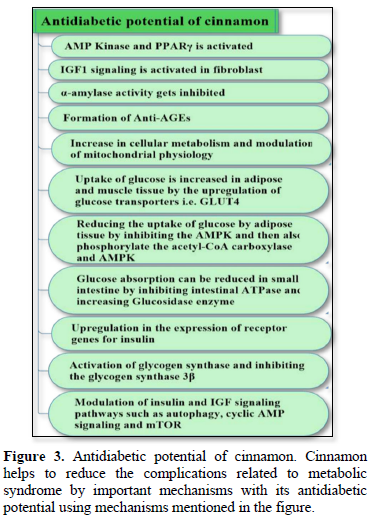

Strawberry (Fragaria ananassa)
Strawberry belongs to the Rosacea family and the edible part of the fruit is achene and it has 81% of antioxidant potential. It is the major source of vitamins, flavonoids, catechin, potassium, carotenoids, folic acid, and quercetin. It contains a high amount of phenolic acids and according to the researchers, there are more than 25 anthocyanin pigments in different varieties of strawberry [4]. Strawberry has a unique flavor, having the best source of vitamin C and knowing about the antidiabetic as well as antioxidant potential. Phytochemicals from strawberry juice are screened by using HPLC [31]. Strawberry has more fiber content; its nutritional value and taste can vary due to environmental factors as well as genetic variation [19]. The risk of diabetes and diabetic complications can be reduced by the intake of natural polyphenols [32]. The role and functions of plant food polyphenols is briefly explained in Figure 4 [33]. Strawberry has the main component that is polyphenols these compounds provide or a source of every character present in fruits. Characteristics include color, flavor, and aroma, due to their presence fruits are considered to be healthy and they are full of nutrients, antibacterial, antifungal, anti-inflammation, reducing the risk of obesity, having high antioxidant potential and antidiabetic activity additionally [34]. Phytochemicals in mixture are more effective than their individual or purified form [35].
Phytochemicals are of hundred types in which two-third parts are flavonoids and one third are phenolic acids [36]. Strawberry phytochemicals include flavonoids which contains a high amount of anthocyanin and ellagic acid which is the important compound in strawberry [37]. A brief study about nutrient contents in fresh strawberries is given in Table 3 [38].
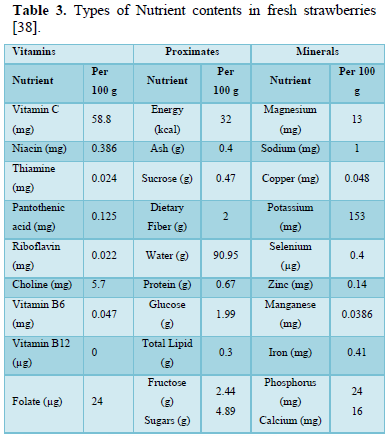
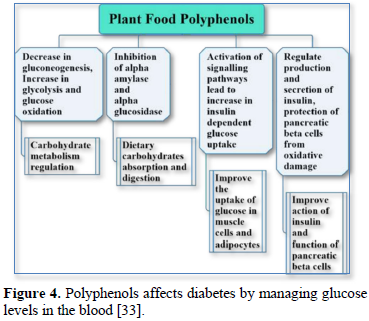


Strawberry is considered to be more useful because it can help to manage Type 2 diabetes having such type of phenolic compounds that has more α-glucosidase inhibitory activity and low α- amylase activity [39]. Polyphenols in strawberry like anthocyanin is responsible for the red color in strawberry and they are mainly glycosides. It is involved in the regulation of the metabolism of carbohydrate. It improves the insulin signaling pathway and the glucose transporters. On the other side presence of increased Vitamin C decrease the production of sorbitol due to which diabetic complications related to Type 2 Diabetes become lowered [4]. Kaempferol present in strawberry is the subclass of flavonoids. These flavonoids protect the β-cells from damaging by inhibiting the caspase 3 activity and improves the BCl2 action. Quercetin helps in glucose absorption by the mediation of glucose transporters by acting on the AMP activating protein kinase. Catechin acts on the intestinal membrane by inhibiting the action of glucose transportation; thus, helps to lower blood glucose levels. Anthocyanins and anthocyanidins help in the upregulation of glucose transporters and cause delay in the absorption of glucose which is due to inhibition of carbohydrate metabolism so that glucose will not release, leading to the reduction of postprandial hyperglycemia and improving the insulin sensitivity [8]. In one research, total phenolic content in strawberry recorded was 0.3- 0.7 mg/g FW and total antioxidant activity 42-90% was reported. In another research inhibitory activity on α-glucosidase was 72-90% and on α-amylase 15-50% was recorded [5].
Mulberry (Morus)
It belongs to the family of Moraceae having total 24 species and almost 100 varieties that are still known yet, there are three common species i.e., red mulberry (Morus rubra), white mulberry (Morus nigra), and black mulberry (Morus alba). Mulberry has a great impact on human health providing many nutritional benefits preventing many diseases especially Type 2 Diabetes. Mulberry has a high amount of phytochemicals mainly phenolic acids and flavonoids [17]. The plant is 10-12 m in height and is monoecious and dioecious. There are also dozens of species of this plant grow in other countries in temperate and tropic regions [2]. Some clinical studies were carried out on animals (mice). Researchers’ first induced diabetes in mice by streptozotocin and used mulberry fruit and leaves extracts to check its effect. They showed a decrease in glucose level in those animals. They identified the bioactive compounds in them that were responsible for hypoglycemic activity through HPLC. The compounds obtained were ethanol, rutin, astragalin, methanol, isoquercetin, caffeic acid, and kaempferol. One gram of mulberry leaf extract in a day claims many health benefits. This helps to cure atherosclerosis, enhancing immunity, diabetes, lowering the risk of cancer, and better antioxidant potential [40].
Morus alba is one of the common specie of Moraceae family. It is also known as white mulberry. It has white or purple color and has a sweet taste. Leaves, root, stem, or fruit are used for many purposes in which important one is diabetes. Chinese have been using mulberry leaves widely to treat diabetes. Mulberry fruit, leaves, stem, and root contain benzo furans, alkaloids, vitamins, minerals, steroids, amino acids, prenylated flavonoids and triterpenes as a major bio-active-components that are responsible for hypoglycemic activity by acting on the pancreas. Some of the components obtained from mulberry are given in Table 4 [41].
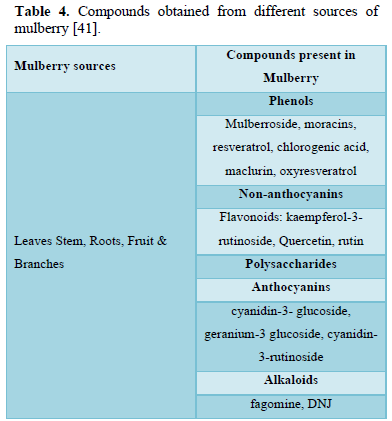

Morus alba leaves extract contributes to an increase in the utilization of glucose stored in adipose cells. Drinking mulberry tea was traditionally used, so an increase in the metabolism of compounds in the large intestine also lowered the level of glucose in the blood. It was clinically proven that both the compounds i.e., glycosides and aglycones play role in managing Type 2 Diabetes [42].
Morus nigra or black mulberry having purple to black color and have sweet and slightly acidic taste. Mulberry contains plant chemicals like bioflavonoids. In Europe, it is used as a stimulating agent for the production of insulin. Its leaves and roots contain deoxy- nojirimycin (DNJ), an alkaloid responsible for lowering blood glucose level. Leaves contain a high amount of DNJ and mostly it has been using as a dietary supplement for diabetes mellitus and hypertension, antidiuretic, and analgesic [43].
Extraction methods are used to determine the quantity and quality of compounds. Previously many techniques were used for extraction like microwave-assisted extraction, ultrahigh-pressure extraction, ultrasound-assisted extraction, and assisted solvent extraction. Some of these techniques are not much efficient due to some factors which cause less efficiency. Ultrasound-assisted extraction that give more extraction efficiency due to low energy consumption, use of less amount of solvent as well as automation of this extraction technique gives more efficiency [44].
In ultrasound extraction techniques sound waves of high intensity are used due to which greater quantity of compounds are extracted from plants and other useful benefit of this technique is less time is required and amount of raw materials is limited [45]. Extraction can give high yield if there will be the use of a high pulsed electric field, increasing temperature, treatment given by microwave, use of high pressure, and sonication [46].
Besides the concern about extraction techniques, there is more concern related to separation techniques in which separation of individual bioactive compounds from the mixture, their reproducibility, their mechanism of action, and their reliability is more important in case of clinical research.
Furthermore, separation techniques that are used mostly for research in mulberry are ion-exchange chromatography, counter current chromatography, silica gel chromatography, gel filtration chromatography, macro porous resins adsorption. Analytical techniques are used in case of quantification of compounds, their identification, profiling and therefore, they are also contributing to increasing the product quality control analytical methods that are widely used and having great value are HPLC, gas chromatography, mass spectrometry [41].
In a study, Morus nigra extract was prepared from leaves and clinical trials were performed on diabetic rats that were treated with streptozotocin 500 mg dose of extract per day increased the level of insulin which caused a decreased in the glucose level in plasma. Still, there are not any reports published related to this plant that show antidiabetic effects.
- nigra have many adverse effects that have been evaluated related to obesity, cardiovascular diseases, and risk of cancer and kidney problems [47].
In vitro and in vivo test was performed on Morus alba leaves which shows many pharmacological activities, 5g per day of dose of four weeks helps in controlling the glucose in patients with impaired glucose tolerance [48].
Jamun (Syzygium cumini)
- cumini is related to the family of Myrtaceae. This genus has almost species 1100. In history this plant had many uses in which its oils have many medicinal properties. This plant is edible [49]. There are also other names of S. cumini i.e., Eugenia cumini, Eugenia jambolina, and Syzygy jambolanum. Other common names of Jamun are Jaman, java plum, jambolan, jambul, and black plum [50]. Jamun has fleshy appearance with hard seed present in the center, so antioxidant properties are of great value in seed [51]. Seed has glycoside while Jamun stem and bark has carbohydrate and tannins that also play role in diabetes [52]. Jaman contains a significant number of bioactive compounds having an effective function on the pancreas against diabetes. It has also antioxidant potential present in the seed and fruit such as flavonoids, anthocyanins, and phenolic acids. Researchers had already analyzed the pulp of Jaman and extract of jaman fruit was used to treat diabetic rats for 15 days. This study showed a great increase in the insulin production (26.3%). Both Jamun fruit and seed have antidiabetic properties, but the seed has a high potential in reducing glucose levels in diabetic rats as compared to Jamun fruit [53]. Another study showed the effect of fruit pulp of E. jambolina in which water extract of fruit pulp was prepared and 50 mg/kg of the dose was given to the diabetic rats. The outcomes showed a significant decrease in glucose level both in mild and severe cases of diabetic complications. The water extract of E. jambolina showed the reduction of blood glucose level after 90min of its administration due to the reason that the drug takes time to reach the target and further metabolizes [54]. The fruit extract prepared from Jamun stem bark, ethanol extract of bark, and aqueous extract of the leaf has also reduced the level of glucose in diabetic rats. Jamun had also shown its effects in reducing the α-amylase [55]. In a study, Methanol and ethyl acetate extract was prepared from Jamun seed and 200-400 mg/kg dose was given to the Wistar rats by inducing paw edema by carrageenan. The observed data showed the anti- inflammatory activity in them could be beneficial for reducing the inflammatory response linked with diabetes [56].
The nutritional and mineral content of Jamun is elucidated in Table 5 [50]. Malic acid and oxalic acid are the phytochemicals present in Jamun. Malic is the major one whereas oxalic occurs in small amounts, tannins and Gallic acid is responsible for aroma and taste of Jamun fruit, cyaniding diglycosides give fruit the purple color [57].
Jamun is protective in clinical studies, for example, it is radio protective and chemo preventive against many diseases i.e., ulcers, inflammation, diarrhea, and its different compounds were reported to be antibacterial, antifertility, antioxidant, antifungal, and antibacterial. This plant has a high content of compounds i.e., glucosides, isoquercetin, myrecetin, anthocyanins, ellagic acid, and kaempferol. Jamun seed consists of many compounds jambosine, antimellin, alkaloid, and glycoside jambolin that can prevent the conversion of starch in sugar [52]. Various amount of chemical substances are present in fruit which represent total soluble solids and fruit quality and they are found in soluble form [58].
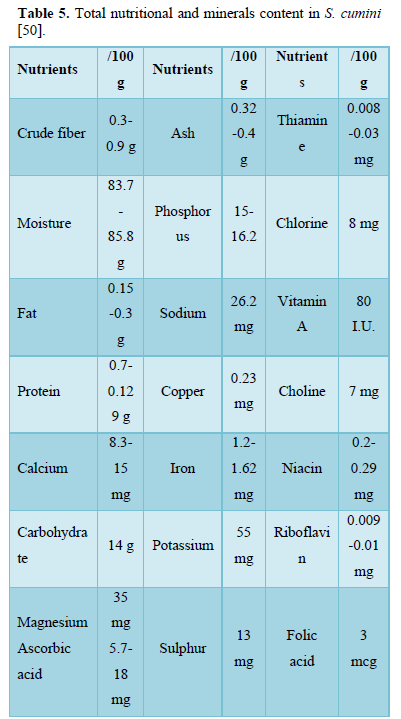

Production of free radicals play a role in the induction of diabetes. Jamun contributes in stimulating many enzymes like increasing the production of glutathione, glutathione-s-transferase and catalase glutathione peroxidase which causes reduction in sugar level. There are many reports in which Jamun showed the reduction of the activity of α-amylase, which is more in case of diabetes. On basis of molecular level, Jamun has suppressed the expression of many transcription factors which are Tumor necrosis factor-alpha (TNF-α), nitric oxide synthase (iNOS), and NF-kB by the upregulation of Peroxisome PPARγ and PPARα (proliferator-activated receptor) which reduced the risk of diabetes. Pancreatic β-cells also function properly by the upregulation of Nrf2 transcription resulting in increase in the antioxidants and reducing the sugar level. As a mechanism of action reducing the sugar level is not well known by Jamun. So, researchers supposed the mechanism of action showing the effects of Jamun on diabetes and cholesterol level in following Figure 5 [55].
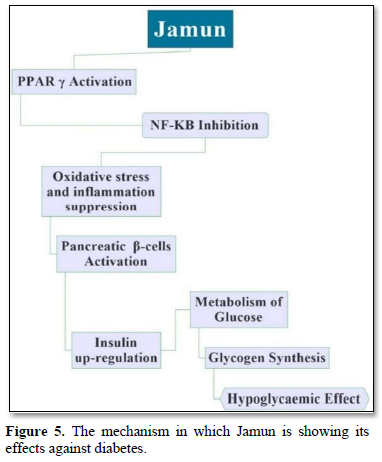

The inhibitors for α-amylase provide efficient strategy against diabetes and by restraining the breakdown of starch postprandial hyperglycemia level can be lowered [59]. Different phytochemicals in many parts of the jaman have been identified. Chemicals present in Jamun leaves are β- sitosterol, myricetin, heptacosane, quercetin, betulinic acid [60]. Bark, seed, and pulp contain flavonoids and phenolic acids. Seed and pulp also contain tannins and terpenes while terpenes have been only found in stem and bark. Anthocyanins are only present in pulp [61]. One of the phytoconstituent that helps to suppress the development of diabetes known to be lupeol. It has high amount of antidiabetic potential due to which insulin level become significantly high [62].
Neem (Azadirachta indica)
Agents obtained from nature are safer, easily affordable, long-term usage with less side effects and helps to regulate the different metabolic signaling pathways. Almost most of the world rely on herbal medicines in which one of the plants is Neem plant. It belongs to the family Mahogany. It is used to treat many chronic as well as acute diseases [63]. Neem can be grown in tropics and subtropics region due to its heat tolerating properties and in dry climate. 400 substances have been reported by HPLC in Neem. Out of them liminoids, nimbins and salannin are the main constituents [64]. Neem is also called as storehouse of various phytochemicals and in other report 300 phytochemicals have been reported. Neem leaves contain essential oil (0.13%). Non- isoprenoids and isoprenoids are the two major forms of phytochemicals derived from Neem. The non-isoprenoids consist of Sulphur compounds, dihydrochalcone, tannins, polyphenolics, aliphatic, proteins, coumarin and polysaccharides while isoprenoids include triterpenoids, limonoids and diterpenoids [63].
Neem leaves also undergo phytochemical analysis in which they contain crude protein 14 to 18%, crude fiber 11 to 24%, phosphorus 0.134.24%, ash 7.7-85%, carbohydrate 48-51%, fat 2.3-6.9%, calcium 0.8-2.4% and amino acids including the 10 essential ones [64]. In one study, extract of Neem root was prepared in 70% alcohol and 800mg/kg of dose showed significant decrease in glucose level in diabetic rats. In another research on diabetic models, hypoglycemic action was noticed at the 15th day after giving the dose of 250mg/kg of Neem extract. In vivo studies on diabetic models by using the extracts prepared from alcohol, chloroform and aqueous. The results showed hypoglycemic action and inhibition of glucosidase activity in intestine so neem has significant antidiabetic potential [65]. Some of the bioactive compounds of Neem and their roles are explained in Table 6.
Hypoglycemic action thorough leaves extract was shown in streptozotocin induced diabetic rats due to presence of flavonoid compound quercetin [66]. 400mg/kg of leaf was prepared from leaf extract of Neem, showed several effects such as lowering the hypercholesteremic activity, anti-hyperglycemia, reducing the lipid peroxidation and lowering of serum glyceride level in rats with alloxan induced diabetes [48]. Greater hypoglycemic activity was lowered when fasting rabbit was fed with Neem oil. Aqueous extract of leaves decreased glucose level by preventing the release of adrenaline. Extract was prepared from seed oil and leaves when scientist performed this experiment on alloxan induced diabetic rats. They rats showed hypoglycemia [67].
In a research extract of Neem was prepared from chloroform and 200-300mg/kg of dose was administered to streptozotocin induced diabetic rats and studies were made both in vivo and in vitro. The results showed inhibition of AGE formation, reduction of enzymatic glycation, increasing antioxidant enzymes, reduction in oxidative stress, enhancing the insulin plasma level, and decreasing lipid peroxidation [48]. Some of the bioactive constituents from different parts of Neem are shown in the Table 7 [67].
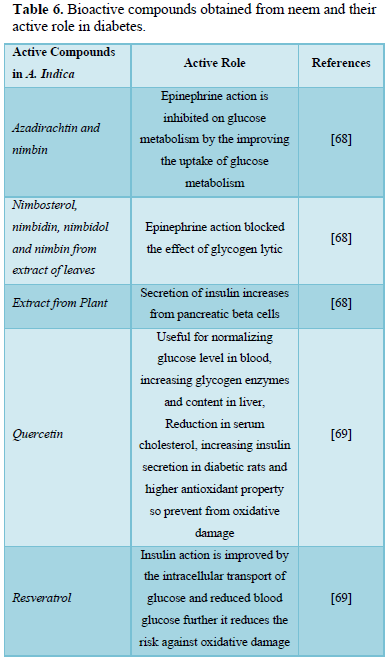

Black pepper (Piper nigrum)
Black pepper has been one of the most widely used spices known to be the “king of spices” in the world. Using in food, it is the major source of dietary polyphenols helps in controlling the Diabetes mellitus and other diseases due to presence of anti-glycation properties in it [70]. Compounds from black pepper are already in use for pharmacological purposes. Percentages of major components of Piper nigrum are given in Table 8. It contains the major alkaloid compound named “piperine”. This component has many applications viz antifungal, antibacterial, anti-inflammation, sore throat, analgesic, anti-cancerous, antidepressant, insecticidal, and it also has application for hyperglycemia regulation [71].
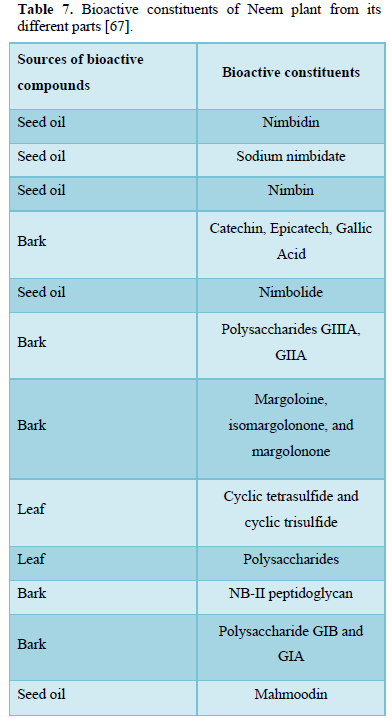

In vitro and in vivo studies were done on the piperine compound. Two experiments were performed. In first experiment piperine dose of 20mg/kg was administered which showed significant decrease in glucose level but at higher concentration of 40mg/kg, this caused increment in blood glucose. Hence, it was proven that appropriate dose administration is required for diabetes. Piperine shows anti-glycation in case of in vitro studies and in case of animal studies anti-hyperglycemic activity was observed [70]. Piperine play role in stimulation of pancreatic and intestinal enzymes which influences the digestive system. Therapeutic effects can be enhanced with the increase in bioavailability of many drugs, vaccines and nutrients due to inhibition of various metabolic enzymes [71].
Black pepper helps to manage glucose and insulin sensitizers and helps liver and muscle cells to use insulin more efficiently [72].
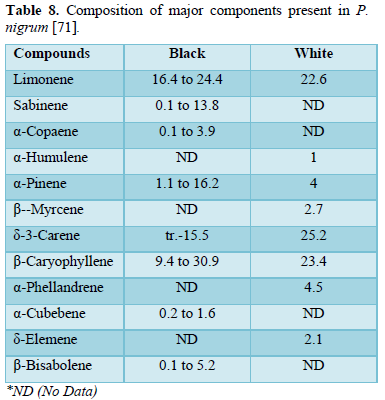

Fenugreek (Trigonella foenum-graecum)
It is related to family of Fabaceae. The compounds of this plant that were studied most are 4-hydroxyisoleucine and diosgenin. These were reported to have antidiabetic activity and dietary fiber were present in soluble fractions of 50-65 g fiber per 100 g of seeds of dietary fiber. It also plays an effective role in enhancing the glycemic control [73]. Fenugreek leaves and root contain ginsenosides and polysaccharides due to them carbohydrate digestion and absorption become slow. They have no effect on glucose transport [56].
Fenugreek has its own importance in term of medical for diabetes and food purposes. Saponin compound present in fenugreek is responsible for the increase in antioxidant enzymes and in the reduction of lipid peroxidation. If there is decrease in the reduction of insulin then inflammation will be reduced and this will not inhibit the insulin action and will ultimately increase the uptake of glucose by the cells and will decrease the plasma glucose level [70]. Figure 6 is showing the mechanism of three main components of Fenugreek.
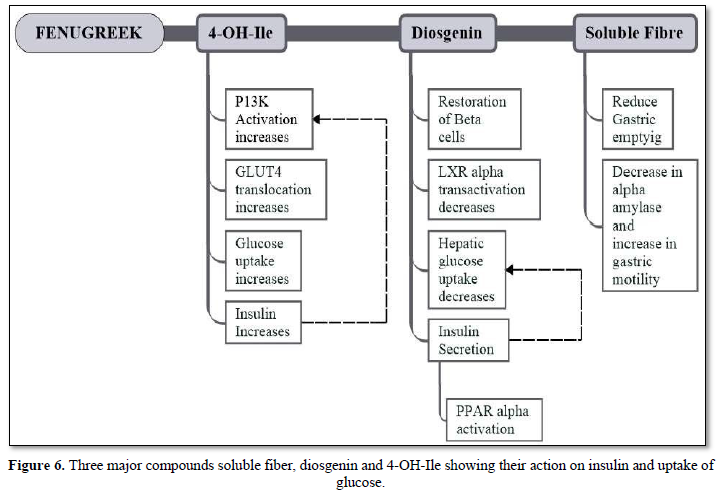

Onion (Allium cepa)
From many centuries, onion has been known for therapeutic purposes. Its name has already in the 35 years old document named Ebers, beneficial for treatment of tumor, for heart diseases and for bites of worm. It also regulates the flow of blood. Almost 25% production of onion has increased in the world. A flavonoid named quercetin is present in the onion reduce the risk of oxidative damage and prevent other organs of body from damage [74].
Strong antioxidant activity and inhibitory activity of α-glucosidase is present in the onion skin. Onion peel and skin increased the antioxidant potential in rats and during screening quercetin was responsible for controlling the free radicals [75]. Onion has almost 660 species and it is related to Liliaceae family. Sodium and lipids are present in low amount. 90% of water is present in it. Dietary fiber and other natural substances that are present in large amount including folic acid, calcium, phosphorus, vitamin B6 and potassium [74]. Phenolic content of onion other active compounds present was caffeic acid, gallic acid, quercetin, protocatechuic acid showed the reduction in α-glucosidase activity [76]. Another reported research in which antioxidant activity was checked in diabetic nephropathy, showed onion possess high antioxidant activity so the potent antioxidants that were reported during research includes organo sulphur compounds such as cepaenes, thiosuplhinates, and anthocyanin pigment. During methanol extract of compounds from onion, scale amount of phenolic compounds were high in case of red onion as compared to white onion [77]. Hypoglycemic activity of onion was also observed by preparing the extract of dried onion with petroleum ether and it controlled the glucose level in diabetic rats induced by alloxan and it can act as substitute for tolbutamide [78].
Feeding the STZ diabetic albino rats with 3% of onion powder in their diet that was freeze dried for 8 weeks and results showed increased hypoglycemia along hypolipidemic and antioxidant activity. In other report 50 mg of single oral dose of onion juice was given to three diabetic patients gave significant decrease in post prandial hyperglycemia in blood [79].
Ginger (Zingiber officinale)
Ginger is grown in tropical regions due to its edible rhizome. It is used for many medical purposes like anti-thrombotic, anti-arthritic, anti-inflammatory and against nausea [80]. It also helps to fight against cancer, hypertension and obesity. It is also used to treat kidney, neural system, and diabetic liver and eye complications. Many experiments were performed in which extract of different doses from ginger was administered which significantly decrease glucose level in blood of diabetic patients [81]. Potentially bioactive compounds present in ginger are gingerols and shogaols, and volatile oils present in them are sesquiterpenes, monoterpenes and β- bisabolene and (-)-zingiberene [80]. The other compounds of ginger with their biological activities are explained in Table 9.
Ginger has two major sharp-tasting compounds 6-Shogoal and 6-Paradol. These compounds promote the utilization of glucose in myotubes and adipose cells. Serum glucose was lowered with the aqueous extract of ginger. Ginger oil have the antidiabetic activity which reduce the activity of aspartate amino transferase and alanine, total lipid in liver and alkaline phosphatase and showed protective mechanism against insulin resistance for diabetes [81].
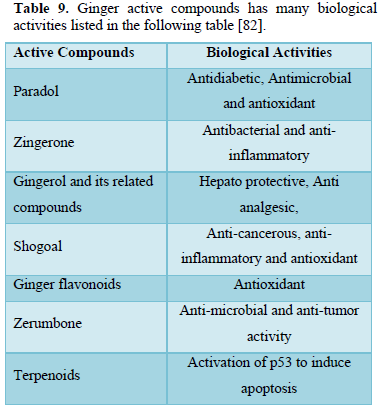
Turmeric (Curcuma longa)
Turmeric is in daily practice for medicinal purposes. It is grown in tropical regions related to the family Scitaminae. Due to its therapeutic potential, it is used for ailment of many diseases such as diabetes, inflammation, obesity, to reduce the risk of cancer and for effective immunity [83]. Turmeric consists of curcumin 2-8%. This helps to improve the hyperglycemia and metabolic problems. Curcumin is responsible for the stimulation of beta cell function that increased the secretion of postprandial insulin level and this effect is due to the ingestion of 6 g of turmeric. One experiment was performed by using turmeric and curcumin present in it decreased the glucose level in plasma by decreasing the gluconeogenesis and increasing glycogen synthesis in liver [84]. Rhizome powder obtained from turmeric plant and ingestion of 6 g of its dose caused an increase in insulin secretion in which curcumin decreased the peroxidation of lipid by increasing the process of antioxidant enzymes such as glutathione S transferase, glutathione peroxidase. Human pancreatic amylase inhibition by the alcoholic extract of curcuminoids reduced the hydrolysis of starch leading to mitigation of glucose level [83]. The phytoconstituents of turmeric and their chemical composition in percentage is given in Table 10.
Administering the compounds extracts to diabetic rats such as curcumin, turmeric or tetrahydrocurcumin decreased the glucose level and glycosylated hemoglobin level. Curcumin can also decrease the oxidative stress by increasing the ratio of NADPH to NADP, increasing the activity of antioxidant enzyme [85].
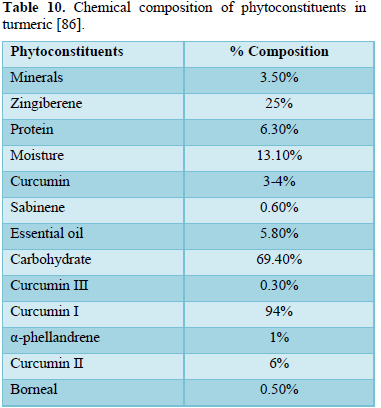

A careful examination was done on the animal models and during experimentation different doses of curcumin at different time interval were administered for 8 weeks. The common dose was 100-300 mg/kg in a day. Animal models were STZ induced genetic models related to diabetes and diet induced; thus, curcumin bioavailability could also be improved by drug delivery systems using cyclodextrins, nanoparticles, micro emulsions, liposomes to improve the action of curcumin and its absorption. The overall action of curcumin for glucose metabolism is in Figure 7.
Curcumin in case of Type 2 diabetes plays an effective role by decreasing the production of hepatic glucose, AMP activation, suppresses the inflammation in case of hyperglycemia, increase in the gene expression of glucose transporters i.e., GLUT2, GLUT4 and GLUT4, and it increases the uptake of glucose in cells. Curcumin suppresses the glucose level by the activation of receptors PPARγ [87].
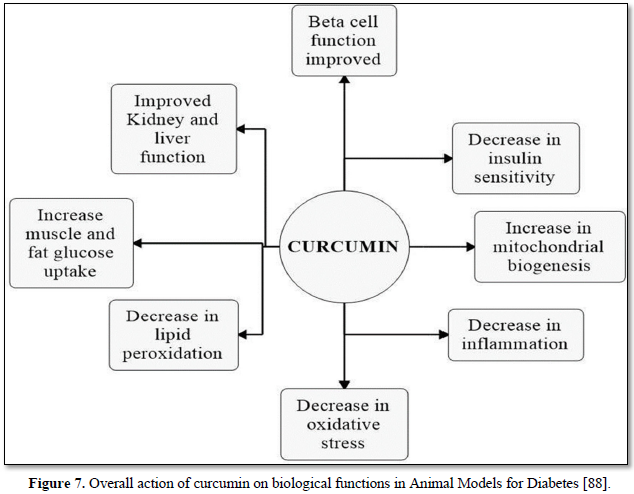

Grapefruit (Citrus × paradise)
It is popular citrus fruit having more vitamin C and fiber content with low calories from other fruits like apple, strawberry or banana, rich in folic acid, improves digestion in body preventing from CDV diseases, making immune system strong and other benefits for human health. Drinking juice of grapefruit helps in absorption on non-heme iron in body [31].
Grapefruit juice increases the bioavailability of oral drugs for diabetes when it is used with repaglinide. It causes hypoglycemia and this bioavailability of drugs remain for 24 h and increase in this mechanism decreases intestinal or hepatic efflux [89]. Grapefruit has many properties in field of medicine as antifungal, antimicrobial, anti- inflammatory, antioxidant, lowering the cholesterol, against viral infections, fighting against heart diseases and as antidiabetic [31].
In an experiment, muscle cells were treated with naringenin which promoted the uptake of glucose followed by the activation and phosphorylation of AMPK. The in vitro study on effects of naringenin on skeletal muscles is explained in Table 11.
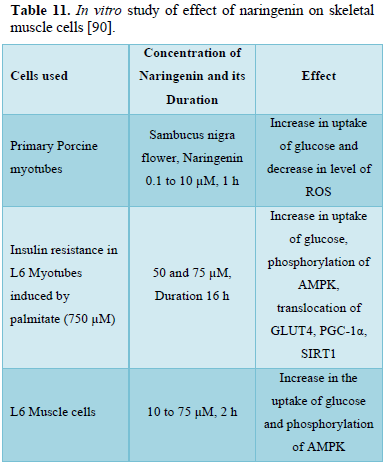

Garlic (Allium sativum)
A spice which is commonly consumed in everyday food from garlic tea to spicy dishes. The reason for this traditional use of garlic is its therapeutic effectiveness. Garlic is being used for medicinal purposes from the ancient times. For instance, it is reported that during the most primitive Olympic Games in Greece, athletes were given garlic in order to increase their stamina. With the advent of technologies, the efficacy and therapeutic usefulness of garlic has also been proved biologically and chemically. Key worth of research on garlic is its maximum therapeutic effect with a minimum toxicity. Higher concentration of Sulfur compounds is responsible for its medicinal effects. It has 33 Sulfur compounds and 17 amino acids. The phytochemical compounds found in garlic are shown in Figure 8. It is used for curing diseases and for prevention of diseases and was also used to spread the infection during Second World War by direct application of garlic on wounds [91].
The scientific name of garlic is “Allium sativum”. It belongs to “Liliaceae” family of Kingdom “Plantae”. It is considered as prophylactic medicinal plant; therefore, it is used for culinary and medicinal purposes [92]. It has different names in different places such as it is called “Lehsan” in Urdu language, “Agilo” in Italian, “Saum” in Arabic, “Ail” in French, “Ajo” in Spanish, “Rashuna” in Bengali and “Suan/Da Suan” in Chinese.
The phytochemical compounds of garlic have a wide range of therapeutic activities. Allicin- sulfur compound of garlic has antimicrobial activities and helps to prevent urinary tract infections. Because of the antioxidant activity of the components of AGE (Aged garlic extract) i.e., SAC (S-allyl cysteine) and fructose arginine, AGE could inhibit the dense cells formation. AGE (4 mg/ml) could deal with sickle cell anemia, a condition in which dense cells, having an irregular membrane and raised density, have a tendency to stick to other blood cells such as platelets, neutrophils, and endothelial cells by inhibiting 50% formation of dense cells, synergistically with other nutrients such as green tea and black tea extract. The list of other medicinal activities of garlic consumption includes antidiabetic activity, immunomodulatory potential, antiviral, antifungal, antioxidant, anti-inflammatory, cardiovascular activity [91].


Antidiabetic Activity of Garlic
Despite of being a cooking spice, garlic have been reported antidiabetic remedy traditionally as well as scientifically. A study was conducted in which compared antidiabetic effect of garlic extract in normal rats and rats with induced diabetes by streptozotocin. They claimed that the effect of garlic extract was more effective than the effect of glibenclamide (antidiabetic drug). The report concluded the garlic as an excellent candidate for the future researches on diabetes mellitus treatment [93].
In 2012, a study was conducted to determine the dietary effect of garlic in obese mice. The mice were regularly administered with garlic extract for 44 days. Their study showed a significant decrease in blood glucose level and body weight by 18.5% and 46.5% respectively. They concluded their observations useful in diet modifications for obese human [94].
A systematic meta-analysis highlighted the significance of garlic as it has beneficial effects on; improving serum levels of blood glucose in fast, glycosylated hemoglobin and consequences of cardiovascular diseases and diabetes. Their results showed that garlic can improve blood levels and lipid profile parameters in patients of diabetes and cardiovascular diseases [95-97].
Garlic has effective impact in bringing down insulin resistance. Volatile sulfur compounds of garlic have shown to be responsible for antidiabetic effects [91]. The latest research to study effect of 3 garlic pieces along with antidiabetic drugs. Their results showed a significant decrease in sugar levels of blood due to the use of garlic pieces along with antidiabetic drug comparing to the effect of antidiabetic drugs alone [98]. Garlic cloves have also been observed experimentally and the bioactive compounds present in them such as S-methyl cysteine transferase. These compounds stimulate insulin production and inhibit the production of glucose [56].
CONCLUSION
There is abundant reported data regarding antidiabetic potential of plants and their use as cost effective traditional medicine easily available for poor people. From early era, people have been treating diseases including diabetes by herbal medicine. In present era researchers are still using conventional medicines and improving the action of medicine effectively with less or no harmful effects. Some studies proved that the compounds extracted from herbal plants, tend to be more effective. Using these medicinal plants with marketed drugs, the plants will more efficiently act on their target sites which will increase the bioavailability of those drugs. Applying this strategy, drugs will be less toxic with less harmful effects. Hundreds of plants including strawberry, mulberry, jaman, garlic, turmeric, grapefruit, cinnamon, black pepper, fenugreek and ginger are reducing the risk of diabetes and many diabetic complications. Strawberry and grapefruit have highest antioxidant potential. It means that they tend to reduce risk of diabetes more efficiently. High amount of vitamin C and fiber contents are present which is good in case of diabetes. Flavonoids tend to play main role in diabetes management by increasing insulin secretion and uptake of glucose to adipose and muscle tissues.
Jamun seed and fruit were considered to be more effective antidiabetic. In diabetes some important mechanism gets disturbed including insulin signaling pathways, breakdown of carbohydrate hydrolyzing enzymes and increases or disruption in the receptor sites of insulin. According to many experimental results phytochemicals have much potential that they can act as inhibitor for carbohydrate hydrolyzing enzymes (inhibition of α-amylase and α-glucosidase) this decreases the glucose level. Some compounds can play the role of activator that can activate some specific receptors including PPARα, PPARγ and TNF-α.
These suppresses the expression of some genes, repairing the insulin signaling pathways and increases the action of insulin which in return contributes in the uptake of glucose. Scientists are improving the use of traditional medicines with the use of better extraction techniques. Because there is need to identify more compounds that can alone act on these target sites as a natural drug. However, their most important mechanism of action is not completely known but scientists are trying to figure out how these compounds and chemicals present in the fruit part of plants are contributing in reducing the level of glucose. These findings will be highly valuable in medical research.
FUNDING INFO
I have no funding for this research.
CONFLICTS OF INTEREST/COMPETING INTERESTS
The authors whose names are listed immediately below certify that they have NO affiliations with or involvement in any organization or entity with any financial interest (such as honoraria; educational grants; participation in speakers’ bureaus; membership, employment, consultancies, stock ownership, or other equity interest; and expert testimony or patent-licensing arrangements), or non-financial interest (such as personal or professional relationships, affiliations, knowledge or beliefs) in the subject matter or materials discussed in this manuscript.
ETHICS APPROVAL
This material is the authors’ own original work, which has not been previously published elsewhere.
CONSENT TO PARTICIPATE (ETHICS)
I also consent to participate in a survey and interview to be conducted by a research assistant after the academic session has concluded. I understand that my contribution will be confidential and that there will be no personal identification in the data that I agree to allow to be used in the study.
CONSENT TO PUBLISH (ETHICS)
I, the undersigned, give my consent for the publication of identifiable details, which can include photograph(s) and/or case history and/or details within the text to be published in the above Journal and Article.
AUTHORS’ CONTRIBUTIONS
The authors mentioned in manuscript contributed equally.
- Mandave P, Khadke S, Karandikar M, Pandit V, Ranjekar P, et al. (2017) Antidiabetic, lipid normalizing, and nephroprotective actions of the strawberry: A potent supplementary fruit. Int J Mol Sci 18(1): 124.
- Venkatesh RK, Chauhan S (2008) Mulberry: Life enhancer. J Med Plant Res 2(10): 271-278.
- Choudhury H, Pandey M, Hua CK, Mun CS, Jing JK, et al. (2018) An update on natural compounds in the remedy of diabetes mellitus: A systematic review. J Tradit Complement Med 8(3): 361-376.
- Deayu MP, Wiboworini B, Dirgahayu P (2020) The effect of strawberry on type 2 diabetes mellitus: A review. Int J Nutr Sci 5(1): 1-6.
- Sarkar D, Shetty K (2014) Metabolic Mobilization Strategies to Enhance the Use of Plant-Based Dietary Antioxidants for the Management of Type 2 Diabetes. In Aging, Elsevier. pp: 289-296.
- Halban PA, Polonsky KS, Bowden DW, Hawkins MA, Ling C, et al. (2014) β-Cell Failure in Type 2 Diabetes: Postulated Mechanisms and Prospects for Prevention and Treatment. J Clin Endocrinol Metabol 99(6): 1983-1992.
- Piero M, Nzaro G, Njagi J (2015) Diabetes mellitus-a devastating metabolic disorder. Asian J Biomed Pharm Sci 5(40): 1.
- Tanveer A, Akram K, Farooq U, Hayat Z, Shafi A (2017) Management of diabetic complications through fruit flavonoids as a natural remedy. Crit Rev Food Sci Nutr 57(7): 1411-1422.
- Tundis R, Loizzo M, Menichini F (2010) Natural products as α-amylase and α- glucosidase inhibitors and their hypoglycemic potential in the treatment of diabetes: An update. Mini Rev Med Chem 10(4): 315-331.
- He J-H, Chen L-X, Li H (2019) Progress in the discovery of naturally occurring anti- diabetic drugs and in the identification of their molecular targets. Fitoterapia 134: 270-289.
- da Silva Almeida JRG, Souza GR, da Cruz Araújo EC, Silva FS, de Lima JT, et al. (2012) Medicinal plants and natural compounds from the genus Morus (Moraceae) with hypoglycemic activity: A review. Glucose Tolerance pp:
- Tariq A, Sadia S, Fan Y, Ali S, Amber R, et al. (2020) Herbal medicines used to treat diabetes in Southern regions of Pakistan and their pharmacological evidence. J Herb Med 21: 100323.
- Abdulazeez SS (2014) Effects of freeze-dried Fragaria x Ananassa powder on alloxan- induced diabetic complications in Wistar rats. J Taibah Univ Medical Sci 9(4): 268-273.
- Mandal A (2020) Nutraceutical and Medicinal Property of Mulberry Fruits: A Review on Its Pharmacological Available online at: https://www.preprints.org/manuscript/202004.0105/v1
- Wang Y, Xiang L, Wang C, Tang C, He X (2013) Antidiabetic and antioxidant effects and phytochemicals of mulberry fruit (Morus alba L.) polyphenol enhanced extract. PloS One 8(7): e71144.
- Petrovska BB (2012) Historical review of medicinal plants’ usage. Pharmacogn Rev 6(11): 1.
- Sánchez-Salcedo EM, Mena P, García-Viguera C, Martínez JJ, Hernández F (2015) Phytochemical evaluation of white (Morus alba ) and black (Morus nigra L.) mulberry fruits, a starting point for the assessment of their beneficial properties. J Funct Foods 12: 399-408.
- Mradu G, Saumyakanti S, Sohini M, Arup M (2012) HPLC profiles of standard phenolic compounds present in medicinal plants. Int J Pharmacogn Phytochem Res 4(3): 162-167.
- Afrin S, Gasparrini M, Forbes-Hernandez TY, Reboredo-Rodriguez P, Mezzetti B, et al. (2016) Promising health benefits of the strawberry: A focus on clinical studies. J Agric Food Chem 64(22): 4435-4449.
- Kavishankar G, Lakshmidevi N, Murthy SM, Prakash H, Niranjana S (2011) Diabetes and medicinal plants-A review. Int J Pharm Biomed Sci 2(3): 65-80.
- Gossell-Williams M, Simon R, West M (2006) The past and present use of plants for medicines. West Indian Med J 55(4): 217-218.
- Sangal A (2011) Role of cinnamon as beneficial antidiabetic food adjunct: A review. Adv Appl Sci Res 2(4): 440-450.
- Bandara T, Uluwaduge I, Jansz E (2012) Bioactivity of cinnamon with special emphasis on diabetes mellitus: A review. Int J Food Sci Nutr 63(3): 380-386.
- Shihabudeen HMS, Priscilla DH, Thirumurugan K (2011) Cinnamon extract inhibits α-glucosidase activity and dampens postprandial glucose excursion in diabetic rats. Nutr Metabol 8(1):
- Rao PV, Gan SH (2014) Cinnamon: A Multifaceted Medicinal Plant. Evid Based Complement Alternat Med 2014: 642942.
- Al-Samydai A, Al-Mamoori F, Shehadeh M, Hudaib M (2018) Anti-Diabetic Activity of Cinnamon: A Review. Int Res J Pharm Med Sci 1(5): 43-45.
- Muhammad DRA, Dewettinck K (2017) Cinnamon and its derivatives as potential ingredient in functional food - A review. Int J Food Prop 20(2): 2237-2263.
- Mbaveng A, Kuete V (2017) Cinnamon Species. In Medicinal Spices and Vegetables from Africa. Elsevier. pp: 385-395.
- Vallianou NG, Evangelopoulos A, Kollas A, Kazazis C (2014) Hypoglycemic and hypolipidemic effects of cinnamon. Curr Topic Nutraceut Res 12(4): 127-133.
- Mollazadeh H, Hosseinzadeh H (2016) Cinnamon effects on metabolic syndrome: A review based on its mechanisms. Iran J Basic Med Sci 19(12): 1258.
- Faid SMAEF, Fadlalla EAS, Khojah EY (2017) Anti-diabetic and Antioxidant Effects of Grapefruit, Mango and Strawberry Juice in Streptozotocin - Induced Diabetic Rats. J Appl Life Sci Int pp: 1-13.
- Xiao J, Hogger P (2015) Dietary polyphenols and type 2 diabetes: Current insights and future perspectives. Curr Med Chem 22(1): 23-38.
- Sun C, Zhao C, Guven EC, Paoli P, Simal‐Gandara J, et al. (2020) Dietary polyphenols as antidiabetic agents: Advances and opportunities. Food Front 1(1): 18-44.
- Landete J (2012) Updated knowledge about polyphenols: Functions, bioavailability, metabolism, and health. Crit Rev Food Sci Nutr 52(10): 936-948.
- Amatori S, Mazzoni L, Alvarez-Suarez JM, Giampieri F, Gasparrini M, et al. (2016) Polyphenol-rich strawberry extract (PRSE) shows in vitro and in vivo biological activity against invasive breast cancer cells. Sci Rep 6(1): 1-13.
- Sandra M (2004) Potential impact of strawberries on human health. A review of the science. Crit Rev Food Sci Nutr 44: 1-17.
- Torronen R, Maatta K (2000) Bioactive substances and health benefits of strawberries. Acta Horticulturae 567: 797-803.
- Francesca G, Sara T, José A, Jose L, Bruno M, et al. (2012) The strawberry: Composition, nutritional quality, and impact on human health. Nutrition 28(1): 9-19.
- Lin D, Xiao M, Zhao J, Li Z, Xing B, et al. (2016) An overview of plant phenolic compounds and their importance in human nutrition and management of type 2 diabetes. Molecules 21(10):
- Dimple KA, Kumar V, Tomer V (2018) Traditional medicinal systems for treatment of diabetes mellitus: A review. Int J Pharm Pharm Sci 10(5): 7-17.
- Wen P, Hu TG, Linhardt RJ, Liao S-T, Wu H, et al. (2019) Mulberry: A review of bioactive compounds and advanced processing technology. Trend Food Sci Technol 83: 138-158.
- Bhagour K, Arya D, Gupta R (2016) A review: Antihyperglycemic plant medicines in management of diabetes. Acupunct Relat Therap 4(4): 7-16.
- Yuan H, Ma Q, Ye L, Piao GJM (2016) The traditional medicine and modern medicine from natural products. Molecules 21(5): 559.
- Chen C, You L-J, Abbasi AM, Fu X, Liu RH (2015) Optimization for ultrasound extraction of polysaccharides from mulberry fruits with antioxidant and hyperglycemic activity in vitro. Carbohydr Polym 130: 122-132.
- Gothai S, Ganesan P, Park S-Y, Fakurazi S, Choi D-K, et al. (2016) Natural phyto-bioactive compounds for the treatment of type 2 diabetes: Inflammation as a target. Nutrients 8(8): 461.
- Grajek K, Wawro A, Kokocha D (2015) Bioactivity of Morus alba Extracts-An overview. Int J Pharm Sci Res 6(8): 3110.
- Lim SH, Choi C-I (2019) Pharmacological properties of Morus nigra (black mulberry) as a promising nutraceutical resource. Nutrients 11(2): 437.
- Governa P, Baini G, Borgonetti V, Cettolin G, Giachetti D, et al. (2018) Phytotherapy in the management of diabetes: A review. Molecules 23(1): 105.
- Ayyanar M, Subash-Babu P (2012) Syzygium cumini Skeels: A review of its phytochemical constituents and traditional uses. Asian Pac J Trop Biomed 2(3): 240-246.
- Safdar M, Khan A (2006) Effect of jaman fruit extract on serum, glucose and lipid profile in type-2 Diabetic Individuals. Pak J Nutr 5(6): 573-576.
- Ghosh P, Pradhan RC, Mishra S, Patel AS, Kar A (2017) Physicochemical and nutritional characterization of jamun (Syzygium cuminii). Curr Res Nutr Food Sci J 5(1): 25-35.
- Shrikant BS, Singh NJT, Meghatai MP, Parag MH (2012) Jamun (Syzygium cumini (L.)): A review of its food and medicinal uses. Food Nutr Sci 3(8): 38146.
- Raza A, Butt MS, Suleria HAR (2017) Jamun (Syzygium cumini) seed and fruit extract attenuate hyperglycemia in diabetic rats. Asian Pac J Trop Biomed 7(8): 750-754.
- Sharma SB, Nasir A, Prabhu KM, Murthy PS (2006) Antihyperglycemic effect of the fruit-pulp of Eugenia jambolana in experimental diabetes mellitus. J Ethnopharmacol 104(3): 367-373.
- Jagetia GC (2018) A review on the role of jamun, syzygium cumini skeels in the treatment of diabetes. Int J Complement Alternat Med 11(2): 91-95.
- Chikezie PC, Ojiako OA, Nwufo KC (2015) Overview of anti-diabetic medicinal plants: The Nigerian research experience. J Diabetes Metab 6(6): 546.
- Anjali V, Sindhu G, Girish C (2017) A review on pharmacology and phytochemistry of Syzygium cumini. Indian J Pharm Biol Res 5(04): 24-28.
- Shahnawaz M, Sheikh SA, Nizamani S (2009) Determination of nutritive values of Jamun fruit (Eugenia jambolana) products. Pak J Nutr 8(8): 1275- 1280.
- Gajera HP, Gevariya SN, Hirpara DG, Patel SV, Golakiya BA (2017) Antidiabetic and antioxidant functionality associated with phenolic constituents from fruit parts of indigenous black jamun (Syzygium cumini) landraces. J Food Sci Technol 54(10): 3180-3191.
- Singh Y, Bhatnagar P, Kumar S (2019b) A review on bio-active compounds and medicinal strength of Jamun (Syzygium cumini Skeels). Int J Chem Stud 7(4): 3112-3117.
- Chhikara N, Kaur R, Jaglan S, Sharma P, Gat Y, et al. (2018) Bioactive compounds and pharmacological and food applications of Syzygium cumini - a review. Food Funct 9(12): 6096-6115.
- Khalique A, Rauf A (2016) An overview of Jamun (Eugenia Jambolana): A traditional multipotential drug. Indian J Unani Med IX (2): 71-75.
- Gupta SC, Prasad S, Tyagi AK, Kunnumakkara AB, Aggarwal BB (2017) Neem (Azadirachta indica): An Indian traditional panacea with modern molecular basis. Phytomedicine 34: 14-20.
- Sujarwo W, Keim AP, Caneva G, Toniolo C, Nicoletti M (2016) Ethnobotanical uses of neem (Azadirachta indica A. Juss.; Meliaceae) leaves in Bali (Indonesia) and the Indian subcontinent in relation with historical background and phytochemical properties. J Ethnopharmacol 189: 186-193.
- Alzohairy MA (2016) Therapeutics Role of Azadirachta indica (Neem) and Their Active Constituents in Diseases Prevention and Treatment. Evid Based Complement Alternat Med 2016: 7382506.
- Kadam D, Jadhav Y (2017) Azadirachta indica (neem)-a versatile plant. Peer Rev Multi-Disciplin Int J pp: 287.
- Kumar R, Mehta S, Pathak SR (2018) Bioactive constituents of neem. In Synthesis of medicinal agents from plants. Elsevier. pp: 75-103.
- Govindappa M (2015) A review on role of plant (s) extracts and its phytochemicals for the management of diabetes. J Diabetes Metab 6(7): 1-38.
- Yang DK, Kang H-S (2018) Anti-diabetic effect of cotreatment with quercetin and resveratrol in streptozotocin-induced diabetic rats. Biomol Therap 26(2): 130.
- Bi X, Lim J, Henry CJ (2017) Spices in the management of diabetes mellitus. Food Chem 217: 281-293.
- Salehi B, Zakaria ZA, Gyawali R, Ibrahim SA, Rajkovic J, et al. (2019) Piper Species: A Comprehensive Review on Their Phytochemistry, Biological Activities and Applications. Molecules (Basel, Switzerland) 24(7): 1364.
- Afolayan AJ, Wintola OA (2014) Dietary supplements in the management of hypertension and diabetes - a review. Afr J Tradit Complement Altern Med 11(3): 248-258.
- Ota A, Ulrih NP (2017) An Overview of Herbal Products and Secondary Metabolites Used for Management of Type Two Diabetes. Front Pharmacol 8: 436.
- Suleria HAR, Butt MS, Anjum FM, Saeed F, Khalid N (2015) Onion: Nature protection against physiological threats. Crit Rev Food Sci Nutr 55(1): 50-66.
- Lee S-K, Hwang J-Y, Kang M-J, Kim Y-M, Jung S-H, et (2008) Hypoglycemic effect of onion skin extract in animal models of diabetes mellitus. Food Sci Biotechnol 17(1): 130-134.
- Wu H, Xu B (2014) Inhibitory effects of onion against α-glucosidase activity and its correlation with phenolic antioxidants. Int J Food Prop 17(3): 599-609.
- Bhanot A, Shri R (2010) A comparative profile of methanol extracts of Allium cepa and Allium sativum in diabetic neuropathy in mice. Pharmacogn Res 2(6): 374-384.
- Wadkar K, Magdum C, Patil S, Naikwade N (2008) Antidiabetic potential and Indian medicinal plants. J Herb Med Toxicol 2(1): 45-50.
- Grover J, Yadav S, Vats V (2002) Medicinal plants of India with anti-diabetic potential. J Ethnopharmacol 81(1): 81-100.
- Al-Amin ZM, Thomson M, Al-Qattan KK, Peltonen-Shalaby R, Ali M (2006) Anti-diabetic and hypolipidemic properties of ginger (Zingiber officinale) in streptozotocin-induced diabetic rats. Br J Nutr 96(4): 660-666.
- Otunola GA, Afolayan AJ (2019) A Review of the Antidiabetic Activities of Ginger. In Ginger Cultivation and Its Antimicrobial and Pharmacological Potentials. IntechOpen.
- Rahmani AH, Shabrmi FMA, Aly SM (2014) Active ingredients of ginger as potential candidates in the prevention and treatment of diseases via modulation of biological activities. Int J Physiol Pathophysiol Pharmacol 6(2): 125-136.
- Krup V, Prakash L, Harini A (2013) Pharmacological activities of turmeric (Curcuma longa): A review. J Homeop Ayurv Med 2(133): 2167-1206.
- Selvi NMK, Sridhar M, Swaminathan R, Sripradha R (2015) Efficacy of turmeric as adjuvant therapy in type 2 diabetic patients. Indian J Clin Biochem 30(2): 180-186.
- Niranjan A, Prakash D (2008) Chemical constituents and biological activities of turmeric (Curcuma longa) - a review. J Food Sci Technol 45(2): 109.
- Nasri H, Sahinfard N, Rafieian M, Rafieian S, Shirzad M, et al. (2014) Turmeric: A spice with multifunctional medicinal properties. J Herb Med Pharmacol 3 (1): 5-8.
- Kocaadam B, Şanlier N (2017) Curcumin, an active component of turmeric (Curcuma longa), and its effects on health. Crit Rev Food Sci Nutr 57(13): 2889-2895.
- Den Hartogh DJ, Gabriel A, Tsiani E (2020) Antidiabetic properties of curcumin II: Evidence from in vivo Nutrients 12(1): 58.
- Bailey DG, Dresser GK (2004) Interactions between grapefruit juice and cardiovascular drugs. Am J Cardiovasc Drug 4(5): 281-297.
- Den Hartogh DJ, Tsiani E (2019) Antidiabetic properties of naringenin: A citrus fruit polyphenol. Biomolecules 9(3): 99.
- Singh R, Singh K (2019a) Garlic: A spice with wide medicinal actions. J Pharmacogn Phytochem 8(1): 1349-1355.
- Ajami M, Vazirijavid R (2019) Garlic (Allium sativum). Nonvitamin and Nonmineral Nutritional Supplements. Academic Press. pp: 227-234.
- Liu CT, Sheen LY, Lii CK (2007) Does garlic have a role as an antidiabetic agent? Mol Nutr Food Res 51(11): 1353-1364.
- Djankpa F, Osonuga A, Ekpale J, Quaye C, Otoo P, et al. (2012) Effect of regular garlic ingestion on body weight and blood glucose: A case study in mice. Int J Pharm Sci Res 3(5): 1364.
- Ashraf R, Khan RA, Ashraf I (2011) Effects of garlic on blood glucose levels and HbA1c in patients with type 2 diabetes mellitus. J Med Plant Res 5(13): 2922-2928.
- Hou L-Q, Liu Y-H, Zhang Y-Y (2015) Garlic intake lowers fasting blood glucose: Meta-analysis of randomized controlled trials. Asia Pac J Clin Nutr 24(4): 575.
- Shabani E, Sayemiri K, Mohammadpour M (2019) The effect of garlic on lipid profile and glucose parameters in diabetic patients: A systematic review and meta-analysis. Prim Care Diabetes 13(1): 28-42.
- Dafriani P, Marlinda R, Arman E, Idaman M (2020) Garlic: An alternative in reducing blood glucose on diabetic patients. Int J Community Med Public Health 7(6):










